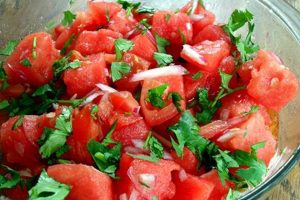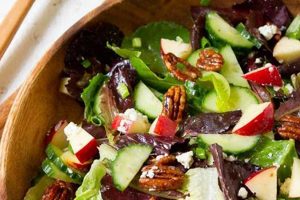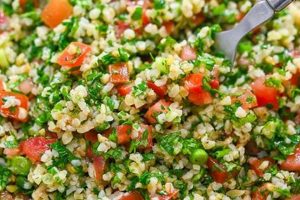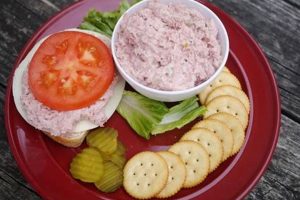A guide for preparing a dish that combines the sweetness of pineapple with the earthy flavor of carrots typically involves shredding or grating carrots and combining them with pineapple chunks. Variations can include additions like raisins, nuts, cream, or a vinaigrette dressing, offering diverse flavor profiles and textures. Specific instructions detail ingredient quantities, preparation steps, and recommended serving suggestions.
This type of dish offers a refreshing and nutritious option, contributing vitamins, minerals, and fiber to one’s diet. The blend of sweet and savory flavors makes it a versatile side dish, complementing various cuisines and appealing to a wide range of palates. Historically, combining fruits and vegetables in salads has been a common culinary practice across different cultures, adapting to locally available ingredients and evolving taste preferences. The accessibility of both carrots and pineapple makes this particular combination a popular choice globally.
This exploration will delve into different variations of this dish, considering factors such as ingredient selection, preparation techniques, and nutritional value. Specific recipes will be examined, showcasing the diverse possibilities and offering practical guidance for creating a delightful culinary experience.
Tips for Carrot and Pineapple Salad Preparation
Optimal preparation ensures a balanced flavor profile and desirable texture. Attention to detail elevates this simple dish, maximizing its appeal.
Tip 1: Carrot Preparation: Grating carrots creates a finer texture, allowing the flavors to meld more effectively. Alternatively, thinly sliced or julienned carrots offer a more substantial texture.
Tip 2: Pineapple Selection: Fresh pineapple provides the best flavor and texture. Canned pineapple can be used, but excess juice should be drained to prevent a watery salad.
Tip 3: Balancing Sweetness and Acidity: A touch of acidity enhances the sweetness of both carrots and pineapple. A squeeze of lime or lemon juice, or a light vinaigrette, achieves this balance.
Tip 4: Enhancing Texture and Flavor: Toasted nuts, such as almonds or walnuts, add crunch and complexity. Raisins or other dried fruits contribute sweetness and chewiness.
Tip 5: Dressing Considerations: A creamy dressing, like Greek yogurt or mayonnaise-based dressing, complements the sweetness. Alternatively, a light vinaigrette offers a refreshing contrast.
Tip 6: Chill Time: Allowing the salad to chill for at least 30 minutes allows the flavors to meld and enhances the refreshing quality of the dish.
Tip 7: Ingredient Ratios: Experiment with different carrot-to-pineapple ratios to find the preferred balance of sweetness and earthiness.
Careful consideration of these elements guarantees a successful and enjoyable culinary outcome. These tips offer a foundation for creating a well-balanced and flavorful dish.
By implementing these suggestions, one can elevate a simple carrot and pineapple salad to a truly satisfying culinary creation.
1. Ingredients
Ingredient selection directly impacts the final flavor profile, texture, and nutritional value of a carrot and pineapple salad. The quality and type of ingredients chosen establish the foundation of the dish. For instance, using fresh pineapple versus canned pineapple affects both the sweetness and texture; fresh pineapple offers a brighter, more vibrant flavor and firmer texture, while canned pineapple tends to be sweeter and softer. Similarly, the variety of carrot employed can influence the overall earthiness and sweetness of the salad. Choosing organic ingredients may also influence flavor and align with dietary preferences. The interplay of these ingredient choices ultimately determines the culinary outcome.
Beyond the core components of carrots and pineapple, additional ingredients introduce further complexity. Incorporating elements such as raisins, nuts, herbs, or spices alters the flavor profile and textural experience. Raisins contribute a chewy sweetness, while nuts, like walnuts or pecans, offer a contrasting crunch and richness. Fresh herbs, such as mint or cilantro, introduce bright, herbaceous notes, while spices like ginger or cinnamon can add warmth and depth. The selection of these supplementary ingredients allows for customization and adaptation to individual preferences, dietary restrictions, and desired flavor profiles. For example, the inclusion of red onion introduces a sharp, pungent note that balances the sweetness of the pineapple, while toasted coconut flakes enhance the tropical character of the salad.
Careful consideration of ingredient characteristics and their interplay within the recipe is essential for a successful outcome. Balancing sweetness, acidity, and contrasting textures creates a harmonious and palatable dish. Understanding the role of each ingredient allows for informed substitutions and adjustments to create variations that cater to specific needs and preferences. This awareness empowers culinary creativity and ensures a consistently satisfying result, highlighting the crucial role of ingredient selection in crafting a delicious and balanced carrot and pineapple salad.
2. Preparation Methods
Preparation methods significantly influence the final texture, flavor release, and overall presentation of a carrot and pineapple salad. Different techniques applied to core ingredients, as well as supplementary components, contribute distinct characteristics to the finished dish. Understanding these methods allows for controlled manipulation of the sensory experience and optimization of the recipe.
- Carrot Treatment
Carrots can be grated, shredded, julienned, or chopped. Grating produces a fine texture, ideal for integrating flavors and creating a softer mouthfeel. Shredding yields longer, coarser strands, offering more textural contrast. Julienned carrots, cut into thin, matchstick-like pieces, present a delicate and elegant appearance. Chopping creates larger pieces, maintaining a firmer texture and visual presence. The chosen method directly impacts how the carrots absorb the dressing and interact with other ingredients.
- Pineapple Handling
Fresh pineapple requires careful preparation, including removing the skin, eyes, and core. Canned pineapple offers convenience but may necessitate draining excess syrup to prevent a watery salad. Dicing or chunking pineapple determines its distribution and visual appeal within the dish. The size and shape of the pineapple pieces influence the overall balance of textures and the perceived sweetness in each bite.
- Ingredient Combination
The order and method of combining ingredients affects flavor development and overall balance. Macerating the carrots in a portion of the dressing before adding the pineapple can enhance flavor infusion and soften the carrots’ texture. Incorporating delicate ingredients, such as fresh herbs, towards the end of the preparation process preserves their vibrancy and prevents bruising. Strategic layering of ingredients within the serving dish contributes to an appealing presentation.
- Dressing Incorporation
The timing and method of adding the dressing influence the final consistency and flavor distribution. Adding the dressing just before serving prevents the salad from becoming soggy. Gently tossing the ingredients ensures even coating and prevents damage to delicate components. Emulsified dressings, such as mayonnaise-based dressings, provide a creamy texture, while vinaigrettes offer a lighter, more refreshing quality. The chosen dressing and its method of incorporation play a critical role in the overall taste and enjoyment of the salad.
The interplay of these preparation methods contributes significantly to the overall success of the carrot and pineapple salad. Careful consideration of each step, from ingredient handling to dressing incorporation, allows for precise control over the final product, optimizing texture, flavor, and presentation. Mastery of these techniques ensures a consistently delicious and visually appealing dish.
3. Flavor Balance
Flavor balance constitutes a critical element in a successful carrot and pineapple salad recipe. Harmonizing the inherent sweetness of pineapple with the earthiness of carrots forms the foundation of a palatable and enjoyable dish. Understanding the interplay of different taste profiles allows for strategic ingredient selection and preparation techniques that optimize the final sensory experience.
- Sweetness Modulation
Pineapple’s pronounced sweetness requires careful management. Balancing this sweetness can be achieved through the incorporation of acidic elements, such as lime or lemon juice, or a tangy vinaigrette. These acidic components cut through the richness of the pineapple, preventing the salad from becoming overly sweet and adding a refreshing dimension. The degree of sweetness can be further adjusted by selecting pineapple varieties with varying sugar content or by controlling the ratio of pineapple to other ingredients.
- Earthiness Enhancement
The earthy notes of carrots contribute depth to the salad, complementing the sweetness of the pineapple. Roasting or caramelizing carrots before incorporating them into the salad intensifies their inherent sweetness and adds a subtle smoky depth. Selecting specific carrot varieties known for their robust flavor profile can also enhance the overall earthiness. Spices, such as cumin or coriander, can further accentuate these earthy notes and create a more complex flavor profile.
- Textural Contrast
While not strictly a flavor element, texture significantly influences the perception of taste. Incorporating contrasting textures adds complexity and interest to the salad. Toasted nuts, such as almonds or cashews, provide a satisfying crunch, while shredded coconut offers a chewy texture. These textural variations create a more dynamic sensory experience, enhancing the interplay of flavors and preventing the salad from becoming monotonous.
- Umami Introduction
Introducing umami, the savory fifth taste, can add another layer of complexity and depth. Incorporating ingredients like toasted sesame seeds or crumbled feta cheese contributes a savory element that balances the sweetness and earthiness. A small amount of soy sauce or fish sauce in the dressing can also introduce umami notes. This addition creates a more well-rounded and satisfying flavor profile.
Achieving flavor balance involves a nuanced understanding of how different ingredients interact and contribute to the overall sensory experience. By carefully considering the interplay of sweetness, earthiness, acidity, texture, and umami, one can craft a carrot and pineapple salad that is not only refreshing and nutritious but also a complex and enjoyable culinary creation. The careful orchestration of these elements elevates the dish beyond a simple combination of ingredients to a harmonious and satisfying culinary experience.
4. Textural Contrast
Textural contrast significantly enhances the sensory experience of a carrot and pineapple salad, elevating it from a simple mix of ingredients to a more dynamic and engaging dish. This interplay of textures adds complexity and interest, stimulating a more satisfying consumption experience. The inherent textures of the core ingredientsthe slight crunch of raw carrots and the tender, juicy nature of pineappleprovide a foundational textural contrast. However, thoughtful additions can amplify this effect considerably.
Consider the addition of nuts. Toasted almonds, walnuts, or cashews introduce a pronounced crunch, juxtaposing delightfully with the softer textures of the fruits and vegetables. The brittle snap of the nuts against the yielding carrot and pineapple creates a multi-faceted mouthfeel. Similarly, seeds, such as sunflower or pumpkin seeds, can be incorporated to achieve a similar textural interplay. Alternatively, incorporating dried fruits, like raisins or cranberries, offers a chewy counterpoint to the other ingredients. This chewiness adds another layer of textural complexity, preventing the salad from becoming one-dimensional.
Shredded coconut provides yet another textural dimension, introducing a slightly fibrous, chewy element that complements the smoother textures of the other components. Even the choice of carrot preparation impacts texture. Grated carrots offer a finer, almost melt-in-the-mouth experience, while coarsely grated or julienned carrots retain a more substantial bite. Recognizing and strategically employing these varied textural elements enhances the overall enjoyment and perceived quality of the carrot and pineapple salad. A well-executed balance of textures transforms the salad from a simple dish into a more sophisticated and satisfying culinary experience.
5. Nutritional Value
Nutritional value represents a significant aspect of a carrot and pineapple salad recipe. This dish offers a combination of vitamins, minerals, and dietary fiber, contributing to a healthy and balanced diet. Understanding the specific nutritional contributions of each ingredient allows for informed choices regarding ingredient selection and preparation methods, maximizing the health benefits of this culinary creation.
- Vitamin A and Beta-Carotene
Carrots are a rich source of beta-carotene, a precursor to vitamin A. Vitamin A plays a crucial role in maintaining eye health, supporting immune function, and promoting cell growth and development. The body converts beta-carotene into vitamin A as needed, offering a readily available source of this essential nutrient. Consuming carrots raw, as in this salad, maximizes beta-carotene availability, as cooking can reduce its concentration.
- Vitamin C and Antioxidants
Pineapple provides a substantial amount of vitamin C, a potent antioxidant that protects cells from damage caused by free radicals. Vitamin C also contributes to collagen production, wound healing, and immune system function. Its antioxidant properties offer protection against chronic diseases. Including fresh pineapple in the salad maximizes vitamin C content, as processing and storage can lead to nutrient loss.
- Dietary Fiber and Digestive Health
Both carrots and pineapple contribute dietary fiber, which plays a crucial role in maintaining digestive health. Fiber promotes regular bowel movements, prevents constipation, and supports a healthy gut microbiome. Adequate fiber intake also contributes to feelings of fullness, aiding in weight management. Consuming the salad without peeling the carrots further enhances fiber content.
- Bromelain and Anti-inflammatory Properties
Pineapple contains bromelain, an enzyme with anti-inflammatory properties. Bromelain may help reduce inflammation throughout the body, potentially alleviating symptoms associated with conditions such as arthritis. While bromelain is primarily found in the core of the pineapple, some of the enzyme remains present in the flesh. Incorporating fresh pineapple in the salad ensures the presence of this beneficial enzyme.
Combining carrots and pineapple in a salad creates a synergistic nutritional powerhouse, delivering a wide range of essential vitamins, minerals, antioxidants, and dietary fiber. Understanding the specific nutritional contributions of each component allows for informed choices regarding ingredient selection, preparation methods, and portion sizes, maximizing the health benefits and aligning the recipe with individual dietary needs and goals. This awareness transforms the salad from a simple dish into a conscious contribution to overall well-being.
Frequently Asked Questions
This section addresses common inquiries regarding carrot and pineapple salad preparation, offering practical solutions and clarifying potential misconceptions.
Question 1: How can excess moisture be prevented in a carrot and pineapple salad?
Excess moisture can dilute flavor and create an undesirable texture. Thoroughly draining canned pineapple is crucial. Fresh pineapple, while preferable for flavor, should also be patted dry after cutting. Salting grated carrots and allowing them to sit for a few minutes before combining with other ingredients draws out excess moisture. Adding the dressing immediately before serving further minimizes moisture accumulation.
Question 2: What dressings complement the flavor profile of carrot and pineapple?
Vinaigrettes with citrus elements, such as lime or lemon juice, effectively balance the sweetness of pineapple. Creamy dressings, like a Greek yogurt-based dressing, offer a richer complement. A light honey-ginger dressing adds complexity while maintaining a refreshing quality. The chosen dressing should enhance, not overpower, the inherent flavors of the ingredients.
Question 3: Can alternative ingredients be substituted for those listed in standard recipes?
Ingredient substitution allows for customization based on dietary restrictions and preferences. Apples or mangoes can offer similar sweetness and texture to pineapple. Shredded cabbage or zucchini can substitute for carrots, offering different nutritional profiles and textural variations. Awareness of flavor and texture compatibility is crucial for successful substitutions.
Question 4: How long can carrot and pineapple salad be stored?
Refrigeration in an airtight container preserves the salad for up to three days. However, optimal flavor and texture are experienced within 24 hours of preparation. Adding the dressing just before serving helps maintain freshness and prevents the salad from becoming soggy.
Question 5: How can the nutritional value of this salad be maximized?
Using fresh, high-quality ingredients maximizes nutrient retention. Minimally processing the ingredients, such as leaving carrot skins intact, preserves fiber content. Incorporating a variety of additional ingredients, such as nuts and seeds, enhances the nutritional profile by adding healthy fats and additional vitamins and minerals.
Question 6: Can this salad be served as a main dish or is it strictly a side dish?
While often served as a side dish, this salad can be adapted into a main course by adding protein sources. Grilled chicken or shrimp, chickpeas, or lentils create a more substantial and complete meal. Adjusting portion sizes and incorporating additional vegetables further enhances its suitability as a main course.
Understanding these key aspects of preparation and storage ensures a successful and enjoyable culinary experience. Careful consideration of these factors optimizes flavor, texture, and nutritional value.
This concludes the frequently asked questions section. The following section will provide specific recipe variations for exploration and enjoyment.
Conclusion
Exploration of carrot and pineapple salad recipes reveals a versatile dish adaptable to various palates and dietary needs. Careful ingredient selection, precise preparation techniques, and attention to flavor balance maximize this simple combination’s potential. Textural contrast and nutritional value further elevate the dish, offering both culinary satisfaction and health benefits. From a refreshing side dish to a substantial main course component, the adaptability of this salad underscores its enduring appeal.
Culinary exploration extends beyond the provided information. Experimentation with ingredients, dressings, and preparation methods allows for personalized interpretations and innovative variations. This encourages culinary creativity and promotes a deeper understanding of flavor profiles and ingredient interactions, ultimately enriching the culinary landscape.






